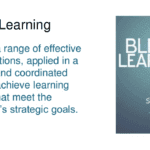This website uses cookies so that we can provide you with the best user experience possible. Cookie information is stored in your browser and performs functions such as recognising you when you return to our website and helping our team to understand which sections of the website you find most interesting and useful.
Why is Transformative Learning so important?

Turn Challenging Dynamics into Transformative Learning, Pt. 2
This is second in a three part series. If you missed part one on empowering knowledge sharing, read it here.
Facilitating a group of people can be both incredibly rewarding and sometimes challenging. The dynamics in a group learning event can be unpredictable, which may require you to respond in the moment to keep everything flowing smoothly.
As the expert leading the group for the hour or day or afternoon, people will be looking to you to guide them. Moments of challenge, handled adroitly, can turn information into inspiration, and the entire program into transformational learning.
Transformational learning includes three elements: psychological—a change in understanding, convictional—a change in belief system, and behavioral—a change in actions. Often if the dynamics in the learning event are mirroring conflictual dynamics in their workplace, the resolution of the challenge will model sound relating, and can facilitate change in belief, behavior or actions. Sometimes it’s not as dramatic as that and you’re dealing simply with a withholding crowd. In either circumstance, participants are learning from you how to be, and what to take into their work.
Now that all learning has pivoted to online, at least for the time being, it’s more important than ever to be prepared. While you lose some of the ways you’re used to assessing group dynamics in the room, you have gained some new tools like chat boxes, instant polls, and putting people in private meeting rooms.
When I train facilitators, I always have a session where I ask them to write down their worst-case scenarios. Then we tackle each one, so they are prepared to deal with them. Here are the most common ones:
You have a group that is very quiet.
This has happened to me and it can be uncomfortable if they aren’t engaging, or worse, not laughing at your awesome jokes. Sometimes, they just need time to warm up. One strategy is just to wait. That silence seems longer to you than it really is, so I encourage you to just breathe and count to 20 in your head. Someone usually speaks up. Sometimes, you truly do have a quiet group. In that case, the best thing to do is make participating easier. This includes having people type their response in the chat box, which actually brings more points of view into the discussion. Another strategy is doing lots of work in pairs and small groups. By now you have hopefully utilized the breakout function in Zoom or other conference call platforms, and can rely on this effective tool in remote events.
Someone is doing all the talking or taking up a lot of time on their individual needs.
At first, I just focus on making it easy for others to participate. I might ask folks to chat in groups and then ask for a volunteer from each group to share some highlights. Or I might go around the room and hear from everyone. If the person persists, move up to saying something more direct like, “I really appreciate your participation—and I’d like to open it up to folks who have not yet had a chance to say something.” And if I need to, I will speak to the person privately during a break, asking them in a kind manner to hold back so we can create space for others.
Someone violates the ground rules.
I think it’s very helpful if ground rules are established at the beginning of the event. Whether you define them or the group creates their own, having ground rules creates a safer container to help everyone participate. Once established, your job is to maintain them so be prepared with ways to gently remind the group about the ground rules because they are counting on you to hold everyone accountable. If the behavior persists, I will then speak to it more directly, getting more firm as needed.
Someone is overly aggressive, making others uncomfortable.
Start with the strategies I just mentioned but be prepared to interrupt someone as needed. If the person seems triggered or upset, I will call a break and connect with them directly to see if we can get them settled. But if the person is truly disruptive and not able to shift, you may need to ask them to leave or get other facilitators or hosts involved.
The existing conflict is hijacking the experience of the whole group.
With a conflict that seems to involve many members of the group, I have found it helpful to give them a choice. I’ll ask if they feel they can set aside their differences long enough to complete the learning program, or if they want to use our time together to resolve the conflict. At this point, I essentially flip the session to be on having difficult conversations and conflict resolution. (This is a topic that you should be prepared to lead if necessary. This is why the more workshops you facilitate, the more adept you get, because you have all this content at your fingertips, and you can be super responsive to your group’s needs.) You can also “freeze” the moment so that people can get a new perspective. I’ll ask people to stop all conversation and say something like, “Let’s stop for a minute. What’s happening here in the room? What different views or opinions are being debated?” This can also be a great way to bring in others, who are not in the conflict, and it also gives people time to breathe and calm down.
A participant openly challenges you in front of the room, questioning your content or your credentials.
Obviously, the more you know your content, the more confident you will be and can calmly address their questions. But if they truly disagree, have some elegant language ready to essentially say that you regret that they feel this way and you need to continue delivering what you were engaged to do.
You make a mistake.
What if you give out wrong information or say something spontaneous that comes out in a way you didn’t intend? If I misspeak, as soon as I notice, I take responsibility for my error and try to fix it. If it’s something I realize later, I will send a follow-up email to the group.
Like anything, facing your worst fears can be really empowering because you know you can handle them if they happen. That doesn’t mean that it’s enjoyable, but the best facilitators can navigate almost any sticky situation while remaining calm and professional.
Turning challenging dynamics into transformative learning is one of the things that distinguishes the best facilitators from the mediocre ones. Knowing how to read your audience and adjusting the workshop to meet their needs is an advanced skill but one that will pay off many times over.
Continue reading for Britt's ten tips to extend learning in your organization >>
This post is adapted from Wired to Grow: Harness the Power of Brain Science to Learn and Master Any Skill. Get a free chapter here.
Related Blogs
JOIN OUR COMMUNITY
Be the first to know of Dr. Britt Andreatta's latest news and research.






